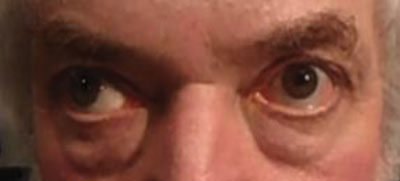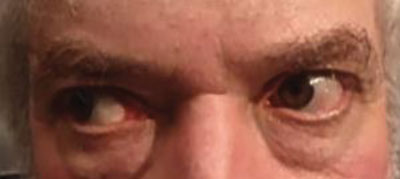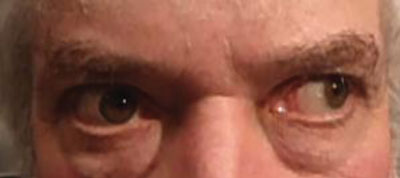Patient experiences intermittent binocular diplopia while driving
Exophoria was present, and horizontal saccades showed rapid initial adduction with slowing and limitation during saccades.
 Catherine A. Cox |
 Jordana F. Goren |
A 63-year-old man presented to the emergency department with 1 day of intermittent horizontal binocular diplopia lasting for 5 minutes at a time. The diplopia was present while driving or walking, and it was relieved by using an eye patch over either eye. He denied any other vision changes or headaches. Review of systems was negative for any weakness, fatigue or dysphagia. His last episode of diplopia had occurred in the car while driving to the emergency department.
The patient’s history was significant for bilateral congenital color deficiency, as well as hypertension, hyperlipidemia and depression. His current medications included lisinopril, pravastatin, aspirin and fluoxetine.
Examination
At the bedside, the patient’s visual acuity at near with correction was 20/20 in the right eye and 20/25 in the left. Pupils were normal and there was no ptosis, but an exophoria was present (Figure 1). Extraocular movements were grossly normal with no induced diplopia. On slit lamp biomicroscopy, the patient was noted to have mild cataracts and scattered macular drusen. Further attempts to induce diplopia by upward gaze fatigue testing and walking with the patient around the emergency department were unsuccessful. The following day, neuro-ophthalmic evaluation demonstrated a 20 D exodeviation, a small right hypertropia on left upgaze and a small left hypertropia on left downgaze. Horizontal saccades showed rapid initial adduction with slowing and limitation during saccades, more prominent on the right eye than the left (Figures 2a and 2b).
 Figure 1. Right exophoria before recompensation. Images: Shah NN, Hedges TR
|
 |
 Figure 2. Lateral gaze to the right and left. |

What is your diagnosis?
Binocular diplopia
Based on the patient’s initial presentation, myasthenia gravis and intermittent decompensation of an existing phoria were high on our differential. Inability to induce fatigue with upward gaze testing made myasthenia gravis less likely. The subtle adduction abnormality found on follow-up examination broadened our differential to include both internuclear ophthalmoplegia (INO) and pseudo-INO syndromes, such as thyroid eye disease, Miller Fisher syndrome, botulinum toxicity and chronic progressive external ophthalmoplegia. Myasthenia gravis can also present with a pseudo-INO.
An MRI of the brain was ordered and found to be unremarkable. Blood tests showed a thyroid panel within normal limits but a positive acetylcholine receptor test of 25 nmol/L. This confirmed a diagnosis of myasthenia gravis. The patient was started on oral pyridostigmine, and at a follow-up visit, the patient reported less frequent diplopia.
Discussion
Myasthenia gravis affects women twice as often as men and occurs most often in the third decade of life. It can be classified as ocular, bulbar (with dysarthria or dysphagia) or generalized. Although most cases of ocular myasthenia present with both diplopia and ptosis, it is not uncommon for patients to present with only one of these symptoms.
Myasthenia has a characteristic appearance on ocular motor exam. There is a normal intersaccadic interval, but the medially directed eye moves with either normal or initially increased velocity followed by intrasaccadic slowing. This finding has been termed a “glissade,” a dance term meaning “to glide.” In contrast, eye movements in patients with demyelinating disease are characterized by delayed adduction followed by slow and incomplete excursion.
If ptosis is present on initial examination, an icepack can be placed over the ptotic eye to assess for temporary improvement in lid position. If the patient is asymptomatic at the time of examination, instructing the patient to maintain a fixed upward gaze for 1 minute may induce fatigue and raise suspicion for myasthenia gravis.
The classic test for myasthenia gravis is intravenous injection of edrophonium, a short-acting acetylcholinesterase inhibitor, which temporarily increases acetylcholine levels at neuromuscular junctions. This test is considered positive if it causes a short-term improvement in symptoms. It can lead to bradycardia or cardiopulmonary arrest, however, and is therefore rarely used. An alternative to edrophonium testing is blood work analysis of acetylcholine receptor antibodies. Binding and modulating antibodies are often tested together to increase the overall sensitivity of this test, while blocking antibodies are more useful for monitoring response or progression of the disease. Acetylcholine receptor testing is 80% to 90% sensitive with generalized myasthenia; however, it is only 50% to 60% sensitive with ocular-only involvement. Given its low sensitivity, if receptor antibody testing is reportedly negative but clinical suspicion for ocular myasthenia is high, a false-negative result must be considered. Additional workup may include muscle specific tyrosine kinase antibody testing and T-cell proliferation assays specific for myasthenia gravis.
Summary
Our patient presented with intermittent binocular diplopia, but no systemic symptoms were present and upward gaze testing failed to induce fatigue. Careful ocular motor examination revealed a subtle glissade with adduction, leading to further workup for ocular myasthenia gravis. A positive acetylcholine receptor antibody test confirmed the diagnosis. Our patient was referred for further neurological evaluation and may require an additional corticosteroid or other immunosuppressive therapy for his condition.
References:
- Hedges TR 3rd, Jones A, Stark L, Hoyt WF. Botulin ophthalmoplegia. Clinical and oculographic observations. Arch Ophthalmol. 1983;101(2):211-213.
- Howard FM Jr, Lennon VA, Finley J, Matsumoto J, Elveback LR. Clinical correlations of antibodies that bind, block, or modulate human acetylcholine receptors in myasthenia gravis. Ann N Y Acad Sci. 1987;505:526-538.
- Leeamornsiri S, Chirapapaisan N, Chuenkongkaew W. Clinical profiles of Thai patients with ocular myasthenia gravis in Siriraj Hospital. J Med Assoc Thai. 2011;94(9):1117-1121.
- Oshima M, Deitiker PR, Glenn Smith R, Mosier D, Zouhair Atassi M. T-cell recognition of acetylcholine receptor provides a reliable means for monitoring autoimmunity to acetylcholine receptor in antibody-negative myasthenia gravis patients [published online ahead of print Oct. 10, 2011]. Autoimmunity. doi:10.3109/08916934.2011.611550.
- Quest Diagnostics. Myasthenia gravis and acetylcholine receptor autoantibodies. http://www.questdiagnostics.com/hcp/intguide/jsp/showintguidepage.jsp?fn=FO_MyastheniaGravis.htm. Reviewed December 2010.
- Trakas N, Zisimopoulou P, Tzartos SJ. Development of a highly sensitive diagnostic assay for muscle-specific tyrosine kinase (MuSK) autoantibodies in myasthenia gravis [published online ahead of print Oct. 12, 2011]. J Neuroimmunol. doi:10.1016/j.jneuroim.2011.09.007.
- Weinberg DA, Lesser RL, Vollmer TL. Ocular myasthenia: a protean disorder. Surv Ophthalmol. 1994;39(3):169-210.
- Yee RD, Cogan DG, Zee DS, Baloh RW, Honrubia V. Rapid eye movements in myasthenia gravis. II. Electro-oculographic analysis. Arch Ophthalmol. 1976;94(9):1465-1472.
- Neil N. Shah, MD, and Thomas R. Hedges III, MD, can be reached at New England Eye Center, Tufts University School of Medicine, 800 Washington St., Box 450, Boston, MA 02111; 617-636-4219; fax: 617-636-4866; website: www.neec.com.
- Edited by Catherine A. Cox, MD, and Jordana F. Goren, MD, MS. Drs. Cox and Goren can be reached at New England Eye Center, Tufts University School of Medicine, 800 Washington St., Box 450, Boston, MA 02111; 617-636-4219; fax: 617-636-4866; website: www.neec.com.










